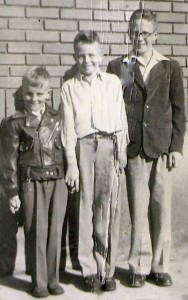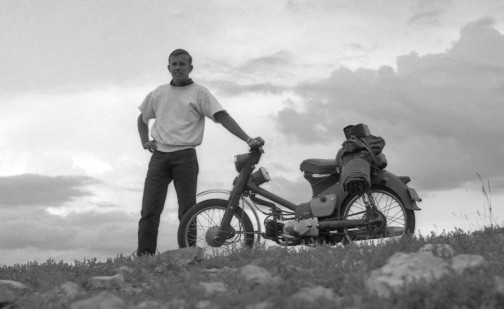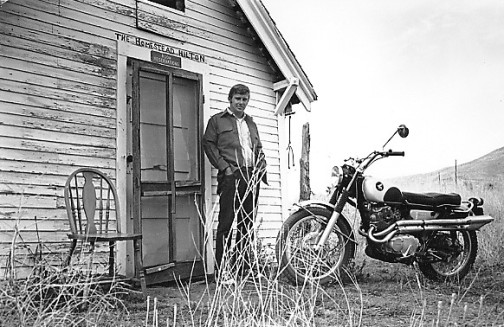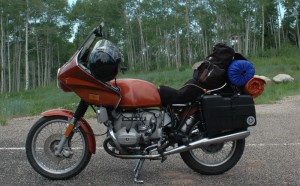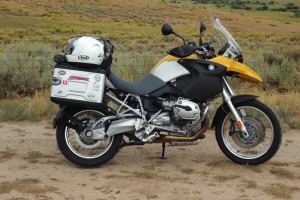It all started years before I was old enough to drive, when for reasons unclear my mother bought me a black leather jacket, and whenever I wore that jacket, I felt like a rebel.
My two older brothers didn’t get motorcycle jackets and as a result both grew up to become responsible adults, whereas in my heart I always aimed to slip the surly bonds of convention—but how? I mean, I was raised Mormon, and Mormons aren’t heavily recruited by motorcycle gangs. Luckily for me, along came a Honda. It came in the form of a gray and blue 50cc Cub, stowed in the bed of a Chevrolet El Camino.
The year was 1960, and I was working as a “used car reconditioning expert” at Redd Motor Company in Price, Utah, when the El Camino with out-of-state plates was towed in for repair. Word filtered down to my bay that the owner was a self-employed freelance journalist, which must have been true because when it came time to pay his bill, he didn’t have the money. As a result, he was forced to part company with the Honda Cub.
The mechanic who bought it promptly bored the engine to 55 cubic centimeters, making it the most powerful Honda Cub in the land. For the next several days I suffered great pangs of envy as said mechanic zipped in and out and all around the shop. Finally, he tired of his new toy and agreed to sell it to me. At long last I owned a motorcycle; sadly, I had to forget about the black motorcycle jacket.
See, in those days Hondas weren’t looked upon as motorcycles—rather, “groovy little motorbikes.” You met the “nicest” people on them—or “ran into them,” as my Aunt Lois used to say. For sure you weren’t one of those Boozefighters come to terrorize Hollister, California.
What I loved about that Honda is that it would go just about anywhere. At every opportunity I would lash my sleeping bag to the fender and set out for the hills. It was the next best thing to having a horse—well, actually, it was better than a horse, because whenever it threw you, you knew that you had no one to blame but yourself. By and by I learned what to look out for and what to avoid, including wildlife on the trail and left-turning Buicks at intersections.
Because I was still a clean-cut Mormon boy, I ended up at Brigham Young University, but I took my Honda along in order to avoid total assimilation into the cult. Most Sundays, you could find me puttering out to Utah Lake or zipping along a dirt road at the base of Provo Peak. Since everyone else was in church, I pretty much had the whole of Happy Valley, plus the leafy glades of Provo Canyon, to myself. And because it’s pretty much impossible to make out on the back seat of a Honda Cub, I managed to graduate without finding a mate, thence settling down and becoming a caterpillar of the community.
Instead, I found myself going the other way. Armed with a bachelor’s degree, I took a job lifeguarding at $1.40 per hour, and after a month had saved up enough for a down payment on a Honda CL77, better known as the 305. The 305 was a very different animal than the 50cc Cub. You didn’t so much sit on it as hang onto it for dear life as you accelerated through the gears. And when you down shifted, the upwardly angled tailpipes reverberated like ack-ack cannon fire.
The year was 1967; free love was in the air and social revolution afoot. Although I was working for minimum wage and living hand-to-mouth in a one-room shack, I soon found myself surrounded by admirers—even acolytes. I was looked up to as one who had dropped out, tuned in and turned on, when in fact all I really had going for me was that wonderful motorcycle.
Meantime, Robert Pirsig had been cruising the existential highway astride a Honda CB77 with the same 305cc powerplant as my CL. So when I read Zen And The Art Of Motorcycle Maintenance, I could readily identify, although I couldn’t help thinking how much better it would be had Pirsig owned an actual road bike. Like, say, his riding companion’s BMW.
Having been passed on the highway by many a Beemer, I’d come to lust after them; however, it wasn’t until many years later, after an aunt died and left me some money that I was able to buy one. (As the saying goes, whenever a dowager dies, her nephew gets his Gold Wing.)
My R80/7 was an older air-cooled BMW twin. With it came an invitation to join the Airheads, which bills itself as a club consisting of “unpretentious owners” of air-cooled BMW motorcycles. I soon found, however, that it’s impossible to ride a BMW without feeling pretentious. So I resigned my membership and have remained unaffiliated since, although I still offer the obligatory benedictory wave whenever I encounter another Beemer on the road.
Sadly, the previous owner of my R80/7 was a tinkerer who had incorporated a number of non-Germanic parts into the electrical system. Beemers just can’t tolerate Radio Shack relays and switches, and last time I found myself riding home in the dark I promised myself that should I somehow survive the ordeal, I’d never ride that bike ever again.
Today, in accordance with the Peter Principle, I’ve moved up to a BMW GS 1200, a machine so powerful and so heavy that it’s impossible to me to even imagine myself acquiring anything bigger. In fact, it’s TOO big for me, but what the heck? Once I’m in the saddle and underway, I no longer feel like a 75-year-old geezer. No, I feel like a kid again, and thanks to my full-face helmet, who’s to say that I’m not?
